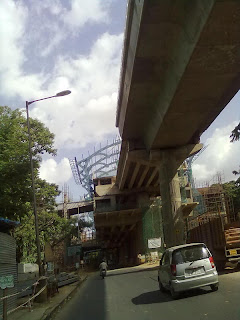The transport ministry will take steps to provide safe, environmental friendly and sustainable public transport. We've always supported public transportation as a means for sustainable development. The idea is that increased use of public transportation will lessen the demand for private transportation , thereby lowering the number of vehicles on the road and lessening vehicle emissions.
Travelling by public transport should not be just convenient but it should be a pleasure . In order to increase the use of public transport in Karnataka, the ministry has initiated several proposals. But here are top five proposals.
1 ) To ensure buses maintain time, Vehicle Tracking System will be installed in 4,000 KSRTC buses. This system will provide information on real time vehicle location and expected time of arrival at any selected bus stand/pickup point. It will also enable people to get real time information through web application/mobile and IVRS. The system will also have a schedule planner which allocates vehicles and crew on weekly basis and parallel operation identification. There will be continuous communication between vehicle and control room. It will provide information on a regular basis enabling KSRTC to take corrective measures in case of any slip-ups .
2 ) For the convenience of common people at the bus stands, 300 passenger information display units will be installed at all bus stands. Real time information on bus movements will be communicated through PIS (passenger information system).
3 ) To make people's travel hassle-free , KSRTC will supply electronic ticketing machines with smart card interfacing to all depots. ETS (electronic ticketing system) will also empower KSRTC traffic/security & vigilance personnel to reconcile bus occupancy numbers with ticketed passengers and authenticate ETM-issued tickets or validated smart cards. ETS will support secure transfer of financial data from ETM through GSM network to a central server at preconfigured intervals . There will be facility for pre-paid cards.
4 ) KSRTC is implementing Intelligent Transport System (ITS) project in Mysore covering 500 buses, 105 bus stops, 6 bus terminals, 45 platforms at a cost of Rs 20.13 cr. It will cover automatic vehicle location information system and PIS providing information display in vehicles, bus stops, bus terminals , bus terminal platforms, one central control station (CCS), and generation of MIS reports.
This system will help in tracking and monitoring of the movement of buses on real time, information to commuters about bus routes and arrival timings of buses at the bus stops/terminals, next stop bus announcement system within bus along with display, facilitates timely management of incidents/accidents etc. The project is under final implementation stage and expected to be completely operational by August 2012.
5 ) In order to in increase frequency of bus service all over the state, 595 new buses will be inducted by March 2013. These include 52 Volvo multi axle buses which includes buses fitted with chemical toilet & pantry cabinet and sleeper coach buses, 42 Rajahamsa buses, 20 Karnataka Vaibhav, 75 front engine semi low floor buses for City operation and 400 NAL-designed Karnataka Saarige buses.
Travelling by public transport should not be just convenient but it should be a pleasure . In order to increase the use of public transport in Karnataka, the ministry has initiated several proposals. But here are top five proposals.
1 ) To ensure buses maintain time, Vehicle Tracking System will be installed in 4,000 KSRTC buses. This system will provide information on real time vehicle location and expected time of arrival at any selected bus stand/pickup point. It will also enable people to get real time information through web application/mobile and IVRS. The system will also have a schedule planner which allocates vehicles and crew on weekly basis and parallel operation identification. There will be continuous communication between vehicle and control room. It will provide information on a regular basis enabling KSRTC to take corrective measures in case of any slip-ups .
2 ) For the convenience of common people at the bus stands, 300 passenger information display units will be installed at all bus stands. Real time information on bus movements will be communicated through PIS (passenger information system).
3 ) To make people's travel hassle-free , KSRTC will supply electronic ticketing machines with smart card interfacing to all depots. ETS (electronic ticketing system) will also empower KSRTC traffic/security & vigilance personnel to reconcile bus occupancy numbers with ticketed passengers and authenticate ETM-issued tickets or validated smart cards. ETS will support secure transfer of financial data from ETM through GSM network to a central server at preconfigured intervals . There will be facility for pre-paid cards.
4 ) KSRTC is implementing Intelligent Transport System (ITS) project in Mysore covering 500 buses, 105 bus stops, 6 bus terminals, 45 platforms at a cost of Rs 20.13 cr. It will cover automatic vehicle location information system and PIS providing information display in vehicles, bus stops, bus terminals , bus terminal platforms, one central control station (CCS), and generation of MIS reports.
This system will help in tracking and monitoring of the movement of buses on real time, information to commuters about bus routes and arrival timings of buses at the bus stops/terminals, next stop bus announcement system within bus along with display, facilitates timely management of incidents/accidents etc. The project is under final implementation stage and expected to be completely operational by August 2012.
5 ) In order to in increase frequency of bus service all over the state, 595 new buses will be inducted by March 2013. These include 52 Volvo multi axle buses which includes buses fitted with chemical toilet & pantry cabinet and sleeper coach buses, 42 Rajahamsa buses, 20 Karnataka Vaibhav, 75 front engine semi low floor buses for City operation and 400 NAL-designed Karnataka Saarige buses.

















































